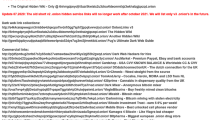Abstract
Cyberbullying is derogatory act carried out intentionally by sending or posting harmful material on social networks to cheat or tarnish anybody’s image in real world. Today it has become a significant problem among teenagers and kids as they spend much time on social networking. Two types of cyberbullying have been observed in the messages posted on social network: direct cyberbullying and indirect cyberbullying. Direct cyberbullying is to send disrespectful/abusing material in the form of text, images, videos and audios to harass/torture individual directly. Indirect cyberbullying is to attack or torture individuals indirectly by doing activities like sending objectionable contents such as false rumors, lies etc. concerning them, tagging their embarrassing images, refuse to socialize with the victim. These type of activities can be viewed by large number of audience on social media. Ground breaking research is being carried out only on the identification of cyberbullying and not on its categories such as direct and indirect cyberbullying. As indirect cyberbullying is much harmful than direct cyberbullying due to the messages posted online are visible to large number of users, which may adversely impact the victim’s reputation/position. So, it becomes necessary to find the solution for this problem. In this paper, we first categorize the messages into direct and indirect bullying messages and then proceed to find the solution for controlling the bullying through checking the credibility of user .




Similar content being viewed by others
References
Kowalski RM, Limber SP, Agatston PW (2008) Cyber-bullying bullying in the digital age, 1st edn. Blackwell, Malden
Willard NE (2007) Cyberbullying and cyberthreats: responding to the challenge of online social aggression, threats, and distress. Research Press, Champaign
Law DM, Shapka JD, Domene JF, Gagné MH (2012) Are cyberbullies really bullies? An investigation of reactive and proactive online aggression. J Comput Hum Behav 28:664–672
Pieschl S, Porsch T, Kahl T, Klockenbusch R (2013) Relevant dimensions of cyberbullying—results from two experimental studies. J Appl Dev Psychol 34:241–252
Dadvar M, Ordelman R, Jong FD, Trieschnigg D (2012) Towards user modelling in the combat against cyberbullying. Paper presented at 17th international conference on applications of natural language to information systems. Springer, Netherlands, pp 277–283
Dadvar M, Jong FD, Ordelman R, Trieschnigg D (2012) Improved cyberbullying detection using gender information. In: Proceedings of the Twelfth Dutch-Belgian information retrieval workshop (DIR2012), Ghent, Belgium, pp 23–26
Dadvar M, Trieschnigg D, Jong FD (2013) Expert knowledge for automatic detection of bullies in social networks. Paper presented at 25th Benelux conference on artificial intelligence, BNAIC, Delft, Netherlands, pp 57–64
Dadvar M, Trieschnigg D, Jong FD (2014) Experts and machines against bullies: a hybrid approach to detect cyberbullies. Paper presented at Canadian conference on AI, Springer, Switzerland, pp 275–281
Ptaszynski M, Dybala P, Matsuba T, Masui F, Rzepka R, Araki K (2010) Machine learning and affect analysis against cyberbullying. In: Proceedings of the linguistic and cognitive approaches to dialog agents symposium. De Montfort University, Leicester, UK
Reynolds K, Kontostathis A, Edward L (2011) Using machine learning to detect cyberbullying. Paper presented at 10th IEEE international conference on machine learning and applications vol 2, pp 241–244
Reynolds K, Kontostathis A, Garron A, Edward L (2013) Detecting cyberbullying: query terms and techniques. In: Proceedings of 5th annual science conference. ACM, New York, pp 195–204
Dinakar K, Reichart R, Lieberman H (2011) Modeling the detection of textual cyberbullying. Paper presented at fifth international AAAI conference on weblogs and social media 2011
Dinakar K, Jones B, Havasi C, Lieberman H, Picard R (2012) Common sense reasoning for detection, prevention, and mitigation of cyberbullying. ACM Trans Interact Intell Syst 2(3) Article 18 MIT Media Lab
Nahar V, Unankard S, Li X, Pang C (2012) Sentiment analysis for effective detection of cyberbullying. In: Proceedings of the 14th Asia-Pacific international conference on web technologies and applications LNCS 7235, Springer, Berlin, pp 767–774
Nahar V, Al-Maskari S, Li X, Pang C (2014) Semi-supervised learning for cyberbullying detection in social networks. LNCS 8506. Springer, Switzerland, pp 160–17
Serra SM, Venter HS (2011) Mobile cyber-bullying: a proposal for a pre-emptive approach to risk mitigation by employing digital forensic readiness. Paper presented at Information Security South Africa, Pretoria, South Africa
Li M, Tagami A (2014) Study of contact network generation for cyber-bullying detection. Paper presented at 28th international conference on advanced information networking and applications workshops
Galán-García P, Puerta JG, Gómez CL, Santos I, Bringas PG (2014) Supervised machine learning for the detection of troll profiles in twitter social network: application to a real case of cyberbullying. Paper presented at advances in intelligent systems and computing, Springer, Switzerland. vol 239, pp 419–428
Fire M, Kagan D, Elyashar A, Elovici Y (2014) Friend and Foe? Fake profile identification in online social networks. J Soc Netw Anal Min 4(1):1–23
Fong A, Zhuang Y, He J (2012) Not every friend on social network can be trusted. Paper presented at IEEE international conference on future generation communication technology (FGCT), London
Perez C, Lemercier M, Birregah B (2013) A dynamic approach to detecting the suspicious profiles on social platforms. In: Paper presented in IEEE international conference on communications. Budapest
Conti M, Poovendran R, Secchiero M (2012) FakeBook: detecting fake profiles in online social networks. Paper presented in IEEE international conference on advances in social networks analysis and mining (ASONAM), Istanbul
Liu H, Lim E-P, Lauw H, Le M-T, Sun A, Srivastava J, Kim YA (2008) Predicting trusts among users of online communities—an Epinions case study. In: Proceedings of the 9th ACM conference on electronic commerce. Chicago, pp 310–319
Davis J, Goadrich M (2006) The relationship between precision-recall and ROC curves. In: Proceedings of the 23rd international conference on machine learning, ACM, Pittsburgh, pp 233–240
Author information
Authors and Affiliations
Corresponding author
Rights and permissions
About this article
Cite this article
Sarna, G., Bhatia, M.P.S. Content based approach to find the credibility of user in social networks: an application of cyberbullying. Int. J. Mach. Learn. & Cyber. 8, 677–689 (2017). https://doi.org/10.1007/s13042-015-0463-1
Received:
Accepted:
Published:
Issue Date:
DOI: https://doi.org/10.1007/s13042-015-0463-1




